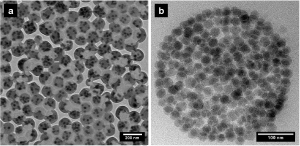Dr. Lena L. Hecht and Dr. David Fellhauer from Karlsruhe Institute of Technology (KIT) are among the winners of the six Ph. D. awards granted by the Helmholtz Association for the first time this year. Hecht, the 31-year-old engineer from the Institute of Process Engineering in Life Sciences, is granted the award in the area of key technologies. The also 31-year-old chemist Fellhauer from the Institute of Nuclear Waste Disposal succeeded with his work in the energy sector. The awards will be handed over at the Helmholtz Annual Meeting on September 19 in Berlin.
“With the awards, the Helmholtz Association wishes to encourage doctoral students to start a career in science. We are happy that Mrs. Hecht and Mr. Fellhauer did so at KIT. They did not only complete their doctorates with excellent results, but also show a high commitment at their institutes,” KIT President Eberhard Umbach says.
In her Ph. D. thesis, Dr. Lena Hecht studied the production of nanostructured particles of some millionths of a millimeter in size with a tailor-made core-shell structure. For this purpose, she used mini emulsion polymerization, a process by means of which smallest molecules loaded with nanoparticles (monomers) are stirred into water and form longer chains (polymers). In this way, precise production of hybrid particles by encapsulation of inorganic material in an organic shell is possible.
“Iron oxide particles can be encapsulated in a polymer and their toxic effect can be suppressed so that they can be used in the human body,” Lena Hecht says. Such particles are applied in magnetic particle imaging, a diagnosis method of high resolution, or in magnetic fluid hypothermia of cancers that have been difficult to treat so far. The particles are introduced into the tumor tissue and heated via a magnetic field. “Structured nanoparticles based on inorganic particles and compounds may also be of interest for other applications in electronics, e.g. in sensors or organic light-emitting diodes,” the engineer adds. “The challenges were to encapsulate high particle concentrations at small particle sizes and to reach a homogeneous filling degree of hybrid particles,” she says. To solve these problems, she combined her know-how of emulsification technology with knowledge of physical, organic, and polymer chemistry. Lena Hecht did her doctorate in early 2013 at the KIT Institute of Process Engineering in Life Sciences, Division I: Food Process Engineering. Since April, she has been heading a research group at this institute. Work focuses on emulsion droplets as reactors and on particle structurization.
.jpg)
.jpg)
Electron microscopies of the metastable and stable Np solid phases controlling Np(V) solubility in CaCl2 solution. (Photos: David Fellhauer, KIT)
Chemical behavior of neptunium and plutonium in aqueous solutions is covered by the Ph. D. thesis of Dr. David Fellhauer. Based on comprehensive experimental work, he was the first to successfully analyze the solubility and chemical form of these long-lived radioactive elements under certain framework conditions. “The experiments focused on solutions that might be of relevance to assessing the safety of nuclear repositories,” David Fellhauer says.
Fellhauer described the characteristics of neptunium and plutonium chemistry observed by newly developed chemical and thermodynamic models. For the first time, he disclosed the behavior of neptunium(V) in calcium chloride solution (CaCl2) and discovered so far unknown calcium-neptunium compounds that control solubility. “The thermodynamic data are important inputs for comprehensive computer-supported model calculations. Such calculations are required to reliably predict the chemistry of radioelements in various development stages of a repository,” the chemist says. Fellhauer’s analyses are the basis of calculating radionuclide retention in repositories. They allow to reliably calculate processes determining the safety of the repository in the long term. David Fellhauer did his doctorate in February this year at the University of Heidelberg. He wrote his Ph. D. thesis at the KIT Institute of Nuclear Waste Disposal (INE) in cooperation with Professor Thomas Fanghänel from the Institute for Transuranium Elements, Karlsruhe. At INE, Fellhauer is presently working as a scientist in the Aqueous Chemistry and Thermodynamics of Actinides Group.
For the first time, the Ph. D. Awards are granted by the Helmholtz Association this year. The awards are to acknowledge outstanding achievements of young scientists at Helmholtz Centres in the Ph. D. phase and supposed to encourage the winners to start a career in science. Apart from the prize money of EUR 5,000, the winners may apply for another EUR 2,000 per month for a stay at a research institution abroad for up to six months.
Being “The Research University in the Helmholtz Association”, KIT creates and imparts knowledge for the society and the environment. It is the objective to make significant contributions to the global challenges in the fields of energy, mobility, and information. For this, about 10,000 employees cooperate in a broad range of disciplines in natural sciences, engineering sciences, economics, and the humanities and social sciences. KIT prepares its 22,800 students for responsible tasks in society, industry, and science by offering research-based study programs. Innovation efforts at KIT build a bridge between important scientific findings and their application for the benefit of society, economic prosperity, and the preservation of our natural basis of life. KIT is one of the German universities of excellence.

